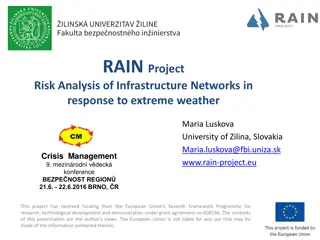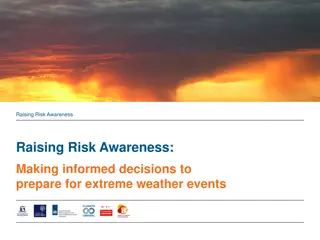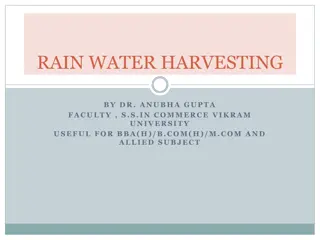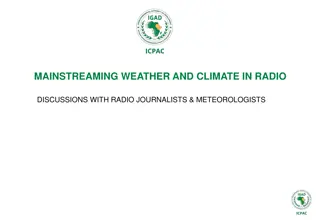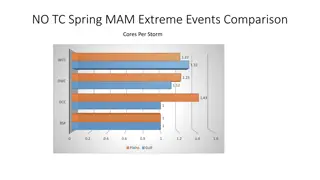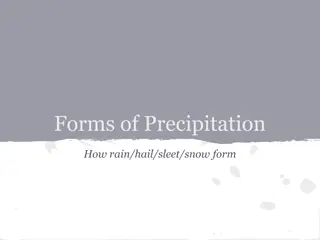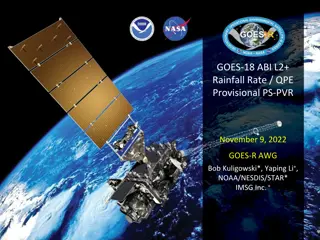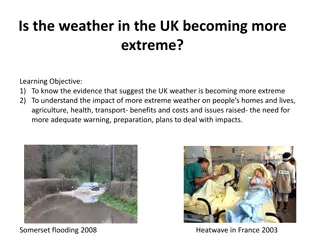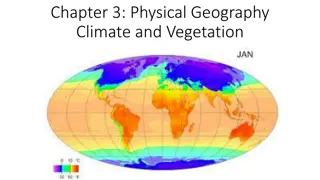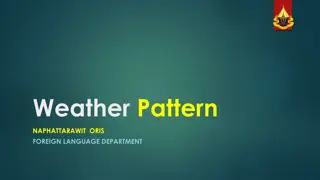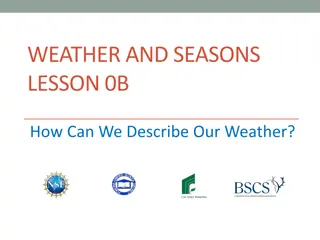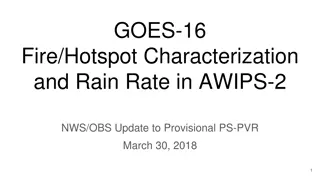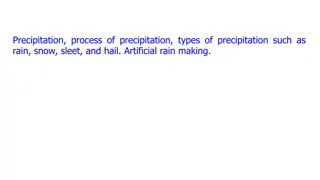RAIN - Risk Analysis of Infrastructure Networks in Response to Extreme Weather
Project RAIN aims to address the impact of extreme weather events on critical infrastructure by developing risk management frameworks and mitigation tools. The project focuses on analyzing vulnerabilities, securing networks, implementing control systems, and designing criteria for building secure infrastructures. The vision is to quantify interactions between weather events and infrastructure systems, considering individual hazards and interdependencies to enhance the security of pan-European infrastructure networks.
Uploaded on Sep 28, 2024 | 0 Views
Download Presentation

Please find below an Image/Link to download the presentation.
The content on the website is provided AS IS for your information and personal use only. It may not be sold, licensed, or shared on other websites without obtaining consent from the author. Download presentation by click this link. If you encounter any issues during the download, it is possible that the publisher has removed the file from their server.
E N D
Presentation Transcript
RAIN - Risk Analysis of Infrastructure Networks in Response to Extreme Weather Dr. Timo Hellenberg/ Dr. Alan O Connor Finnish Final Workshop Helsinki 16th March 2016 www.rain-project.eu This project has received funding from the European Union s Seventh Framework Programme for research, technological development and demonstration under grant agreement no 608166. The contents of this presentation are the author's views. The European Union is not liable for any use that may be made of the information contained therein.
Introduction Project RAIN Risk Analysis of INfrastructure Networks in Response to Extreme Weather FP7 Theme 10 - Security Activity - 10.2 Security of Infrastructures and Utilities SEC-2013.2.1-2 - Impact of Extreme Weather on Critical Infrastructure'. 'Activities will concentrate on targets of an incident or disaster of transnational importance , significant sites of political or symbolic value and utilities being those for energy (including oil, electricity, gas), water, transport (including air, sea, broadcasting), financial, administrative, public health, etc. A series of capabilities are required to cope with this mission area, many of which primarily relate to the phases "protect" but also "prepare . land), communication (including RAIN% Project% ! www.rain(project.eu! Dr.!Alan!O Connor! alan.oconnor@tcd.ie! ! ! ! RAIN Project InfraRIsk Final Workshop 29th September 2016 RAIN!Project!(!Mid!Term!Review!(!Brussels! 9th!December!2015!
Introduction The ambition is both to avoid an incident and to mitigate its potential consequences. emphasis will be on issues such as: analysing, modelling and assessing vulnerabilities of physical infrastructure and its operations; securing existing and future public and private critical networked infrastructures, systems and services with respect to their physical, logical and functional side; control and alert systems to allow for quick response in case of an incident; protection against cascading effects of an incident, defining and designing criteria to build new secure infrastructures and utilities.' RAIN% Project% ! www.rain(project.eu! Dr.!Alan!O Connor! alan.oconnor@tcd.ie! ! ! ! RAIN Project InfraRIsk Final Workshop 29th September 2016 RAIN!Project!(!Mid!Term!Review!(!Brussels! 9th!December!2015!
RAIN Vision To develop a systematic risk management framework that explicitly considers the impacts of extreme weather events on critical infrastructure and develops a series of mitigation tools to enhance the security of the pan- European infrastructure network. To do this we must: quantify the complex interactions between weather events and land based infrastructure systems (i.e. transport, telecoms, energy etc.), develop an operational analysis framework that considers the impact of individual hazards and the coupled interdependencies of critical infrastructure through robust risk and uncertainty modelling, RAIN% Project% ! www.rain(project.eu! Dr.!Alan!O Connor! alan.oconnor@tcd.ie! ! ! ! RAIN Project InfraRIsk Final Workshop 29th September 2016 RAIN!Project!(!Mid!Term!Review!(!Brussels! 9th!December!2015!
Part B - Description of Work Project full title: Risk Analysis of Infrastructure Networks in response to extreme weather Project acronym: RAIN Type of funding scheme: Collaborative Project: Small or medium scale focused research project Work Programme Topics Addressed: SEC-2013.2.1-2 Impact of extreme weather on critical infrastructure Name of Coordinating Person: Prof. Alan O' Connor Trinity College Dublin RAIN Consortium Participant Organisation Name Participant No. Participant Country Short Name 1 (Coordinator) The Provost, Fellows, Foundation Scholars & The TCD Ireland Other Members of Board of the College of the Holy & undivided Trinity of Queen Elizabeth Near Dublin 2 European Sever Storms Laboratory ESSL Germany 3 Zilinska Univerzita V Ziline UNIZA Slovakia 4 Technische Universiteit Delft TU-Delft Netherlands 5 Gavin and Doherty Geosolutions Ltd. GDG Ireland 6 Dragados SA DSA Spain 7 Freie Universitaet Berlin FU-Berlin Germany 8 Roughan & O' Donovan Ltd. ROD Ireland 9 Hellenberg International OY HI Finland 10 Istituto di Sociologia Internazionale di Gorizia I.S.I.G ISIG Italy RAIN% Project% ! www.rain(project.eu! Dr.!Alan!O Connor! alan.oconnor@tcd.ie! ! ! ! 11 PSJ PSJ Netherlands 12 Ilmatieteen Laitos FMI Finland 13 Youris.com Youris Belgium 14 Independent Power Transmission Operator (IPTO) SA IPTO Greece 15 Aplicaciones En Informatica Avanzada SL AIA Spain i RAIN Project InfraRIsk Final Workshop 29th September 2016 RAIN!Project!(!Mid!Term!Review!(!Brussels! 9th!December!2015!
B.1.3S/T methodology and associated work plan B.1.3.1Overall strategy of the work plan The research activities are organised around six technical work packages, each organised around a core topic necessary for the complete description of the problem dynamic. One of these, WP2, focuses on hazard identification, while the second and third work packages, WP3 and WP4 respectively, focus on the elements of critical infrastructure addressed in RAIN. Development of the Risk Analysis framework, identifying measurable risks and benefits, and developing mitigation strategies are cov- ered in WP5, WP6 and WP7. Management and dissemination activities complete the work plan, as indicated in Figure 1.3(a). The diagram also serves to show the interaction and interdependencies be- tween WP s. RAIN Work Package Structure WP Leaders WP1 TCD WP2 ESSL WP3 UNIZA WP4 AIA WP5 TU_Delft RAIN% Project% ! www.rain(project.eu! Dr.!Alan!O Connor! alan.oconnor@tcd.ie! ! ! ! WP6 ROD WP7 GDG WP8 Youris Figure 1.3(a): Work Plan Strategy & Methodological Diagram RAIN Project InfraRIsk Final Workshop 29th September 2016 B.1.3.2Timing of the work plans and their components RAIN!Project!(!Mid!Term!Review!(!Brussels! 9th!December!2015! The timings of each task and the milestones are identified in Figure 1.3(b). It is proposed that the RAIN project will commence in October 2013 and will run for 36 months. The majority of the techni- cal work packages will be completed by Month 24 (WP2 to WP5). While the website and dissemina- tion and communication plan will both be completed at an early stage of the project, they will be sub- jected to reviews on a regular basis. 22
RAIN Project SAVE THE DATE! FINAL CONFERENCE Trinity College Dublin, Friday 24th March 2017 RAIN Project InfraRIsk Final Workshop 29th September 2016
RAIN Project www.rain-project.eu Dr. Alan O Connor alan.oconnor@tcd.ie RAIN Project InfraRIsk Final Workshop 29th September 2016
RAIN Project - Mid Term Review - Brussels 9th December 2015


